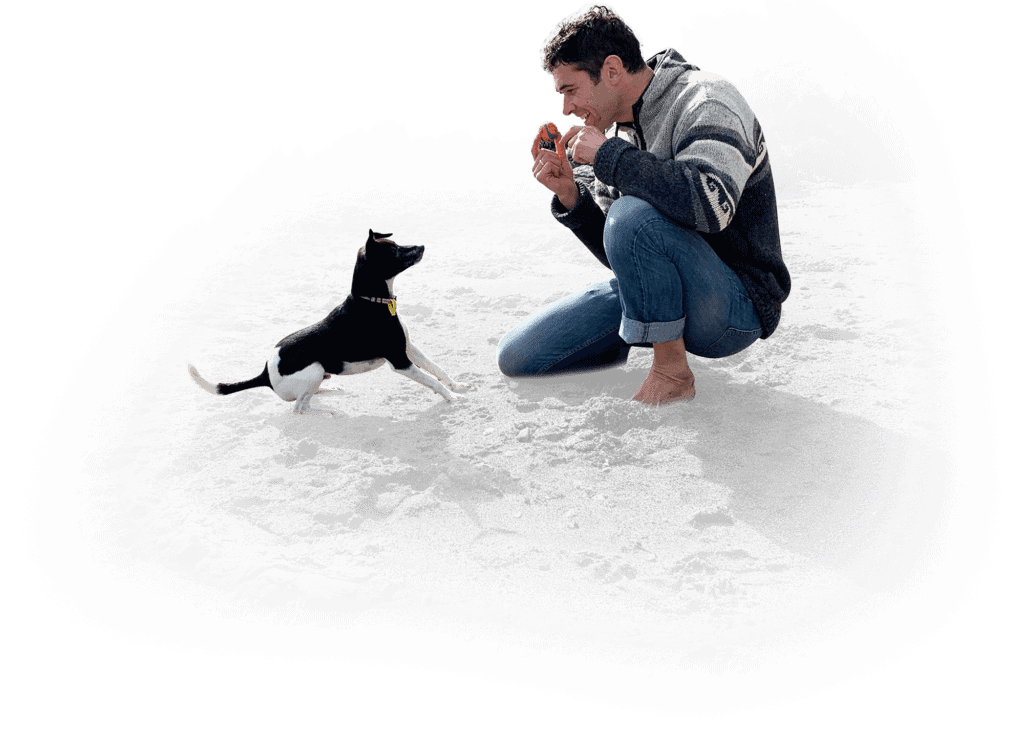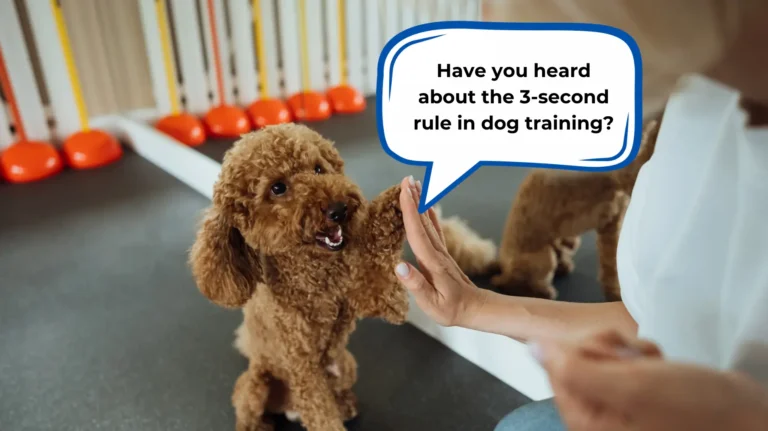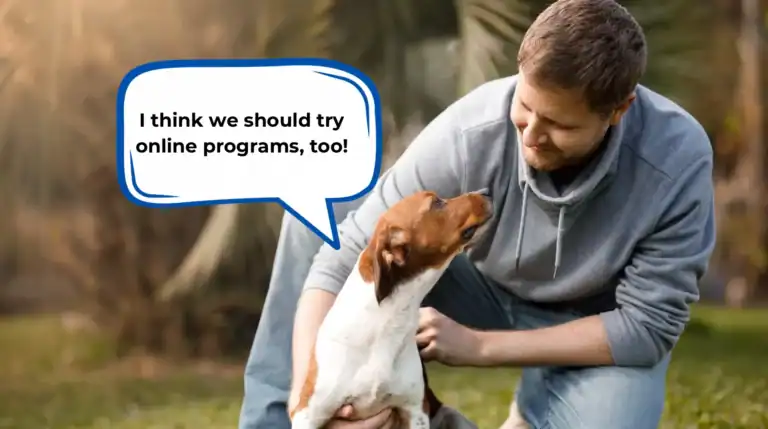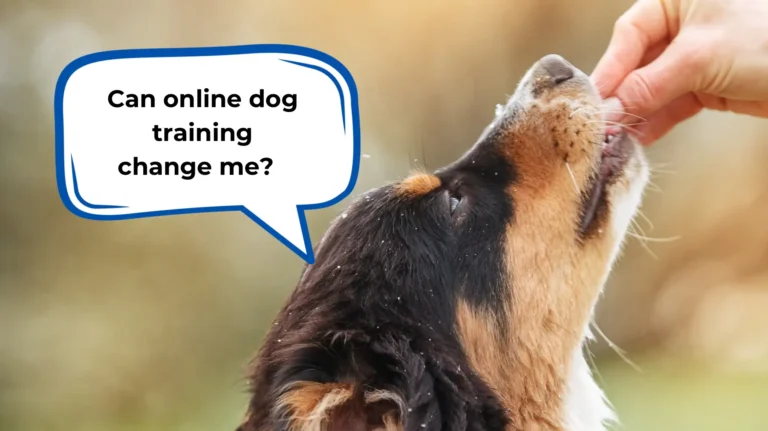In this blog, I'm going to teach you a quick, effective, and safe ways on how to introduce dogs when one is reactive.
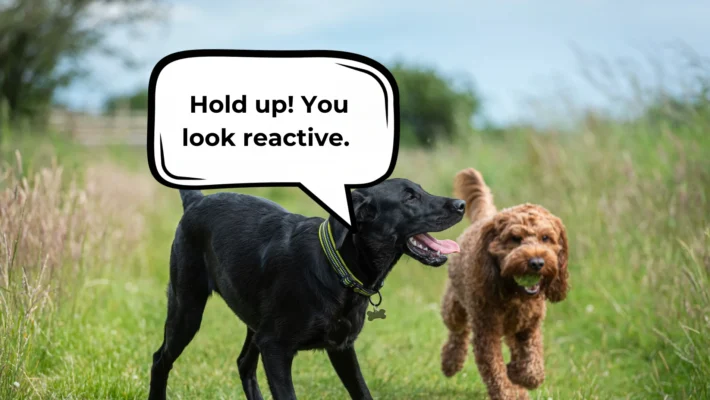
Got a “too much” dog – too jumpy, too barky, too scared? That's reactivity, and it makes dog introductions tricky. With reactivity in the mix, you and your dog will always be on the edge during introductions or socializations.
The secret to success isn't managing chaos, it's preventing it.
This guide is all about proactive calm. Trying to settle adult dogs together (when one of them is anxious and agitated) is like trying to catch smoke.
Instead, we'll show you how to build a calm foundation before they even see another dog. Success starts at home, so setting your own dog up for positive interactions WORKS every time.
Key Takeaways:
- Reactive behavior is often rooted in fear, not aggression. Understanding each and every individual dog is crucial for approaching introductions with empathy. The dog isn't necessarily looking for a fight, but rather trying to protect itself or its owner. This understanding informs the entire training approach.
- Leadership and trust are paramount. Basic commands are less effective than establishing yourself as a clear leader. When a dog trusts your leadership, they feel less pressure to react and are more likely to look to you for guidance in stressful situations. This foundation should be built before attempting introductions.
- Controlled, gradual introductions are essential. Rushing the process can backfire. Starting with scent familiarization, moving to visual introductions at a distance, then gradual proximity, parallel walking, and finally a face-to-face meeting (if appropriate) allows the dog to acclimate at its own pace and builds confidence. Constant monitoring of canine body language and a willingness to retreat are critical.
Table of Contents:
Understanding A Dog's Reactive Behavior
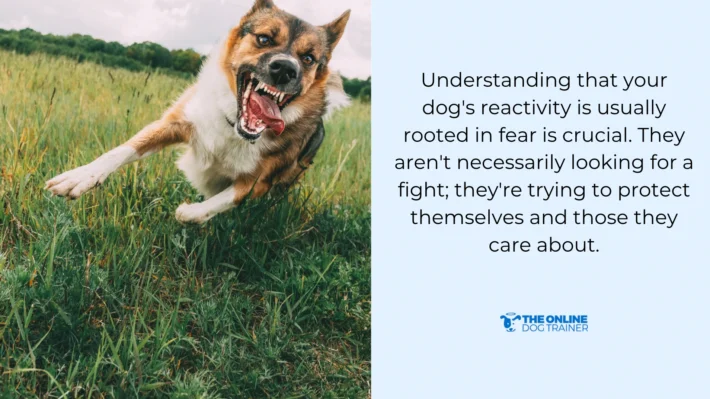
As mentioned earlier, reactive behavior in dogs can stem from various emotions: fear, excitement, aggression, or even over-enthusiasm. However, fear is often the underlying cause, driving dogs to react in ways they perceive as protective. They may fear being attacked themselves, or they may be trying to protect their owners. Some dogs react proactively, striking out first, while others are more hesitant, backing away and only reacting as a last resort.
Ultimately, understanding that your dog's reactivity is usually rooted in fear is crucial. They aren't necessarily looking for a fight; they're trying to protect themselves and those they care about. This understanding helps us approach introductions with empathy and focus on building their confidence.
Preparing for the Introduction: Best Guide for Dog Owners
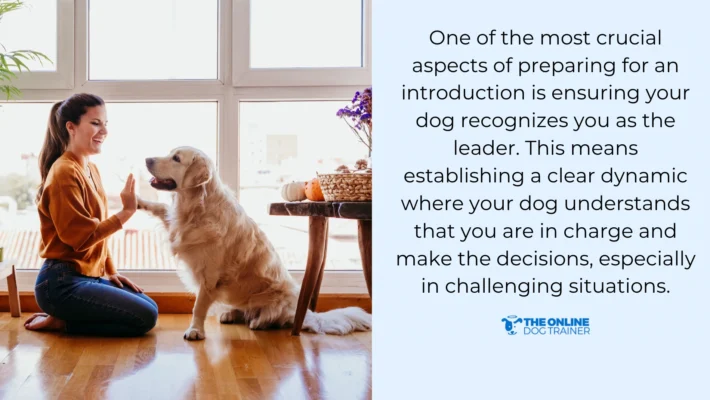
I always tell dog owners to take any dog introduction gradually. Preparing two dogs before the actual meeting can minimize the problems that usually come up in introductions.
Here's how you can do it.
Behavioral Preparation
While many dog trainers emphasize working on basic commands like “sit,” “stay,” and “leave it” to manage reactivity, I've found that these commands often prove ineffective in the presence of triggers, especially if your dog's reactivity is more than just mild. This is because when a dog is in a reactive state, they are in such a high state which makes them not respond to familiar cues. It's like their brain is hijacked by their emotions!
Instead, one of the most crucial aspects of preparing for an introduction is ensuring your dog recognizes you as the leader. This means establishing a clear dynamic where your dog understands that you are in charge and make the decisions, especially in challenging situations. When your dog trusts your leadership, they are more likely to overcome natural aggression, remain calm, and look to you for guidance when faced with potential triggers. This foundation of leadership and trust is best established at home, long before you head to the park for the introduction.
THIS FREE REACTIVITY CLASS WILL HELP CALM YOUR DOG IN A WEEKChoosing the Right Location
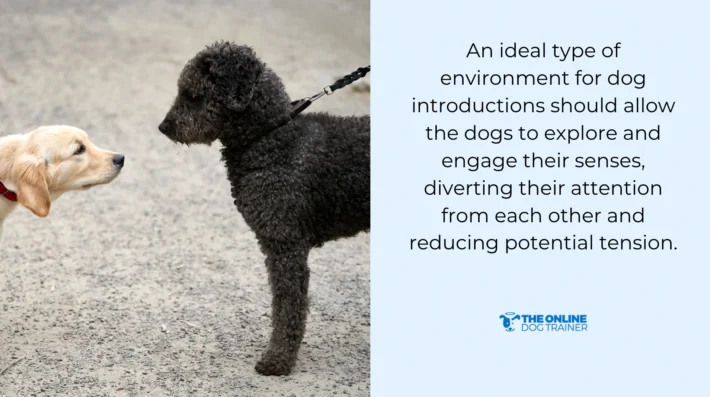
Another key element in preparing for a successful introduction between two or three dogs is choosing the right location. Ideally, you want an open space with plenty of distractions, such as a park with ample grass, interesting smells, and maybe even a water source. This type of environment allows the dogs to explore and engage their senses, diverting their attention from each other and reducing potential tension.
Avoid confined spaces or areas that might induce stress for either you or your dog. Remember, your dog starts to panic when they can sense your emotions, so if you're feeling anxious or stressed, your dog will likely mirror those feelings. A calm and relaxed environment for both of you is crucial.
Gathering Tools
Before the introduction, gather the necessary tools:
- Essentials: A well-fitted harness and a non-retractable leash are crucial for maintaining control over your dog during the introduction. Don't immediately let your dog go off leash during the first meeting.
- Muzzle (If Needed): If there's a possibility of your dog biting, consider using a muzzle as a safety precaution. It's better to be prepared and not need it than to need it and not have it!
- High-Value Treats: Keep some high-value treats on hand for positive reinforcement and redirection. However, use treats cautiously, as they can sometimes increase excitement levels in some dogs.
- Portable Barriers: Portable barriers like pens or fences can be invaluable for controlled introductions. They allow the dogs to see and smell each other without direct contact, which can help reduce stress and anxiety.
Step-by-Step Process for the Introduction
Before bringing your dog to a dog park for socialization, here are some important points to remember.
Step 1: Pre-Introduction Preparation
The first and most crucial step is pre-introduction preparation.
Before the dogs even meet, you need to establish a training plan that'll highlight your clear leadership role. In your training sessions, make sure your dog understands that you are in charge and make the decisions, especially in potentially stressful situations. This is where “The Dog Calming Code” comes in. It's the foundation for creating a calm and balanced dog, and it's often the missing piece in many dog training programs.

When an aggressive dog believes they are in charge, they feel the need to protect themselves and their owners, which can lead to reactivity. By communicating clearly that you are the decision-maker, you take the pressure off your dog and allow them to relax and follow your lead. This shift in mindset can make a world of difference in their behavior.
Step 2: Controlled Visual Introduction
Once you've established a solid foundation of leadership with your own dog, you can move on to the next stage: a controlled, visual introduction. Start by letting the dogs become familiar with each other's scent. You can do this by letting them sniff areas where the other dog has urinated or by exchanging blankets or toys.
Next, gradually bring the dogs closer, allowing them to see each other from a distance. A good starting point is around 100 meters apart, both on leashes. Be mindful of the wind direction, as dogs primarily rely on their sense of smell. Position yourselves so that both dogs can catch the other's scent.
As you slowly reduce the distance, closely monitor your dog's body language for any signs of stress. If your dog shows even slight signs of stress, immediately increase the distance or turn and walk away. This teaches your dog that you are in control and will keep them safe. If your dog remains calm, offer praise and maybe a small treat.
At this stage, avoid forcing any interaction or pulling your dog towards the other dog. Let them acclimate to each other's presence at their own pace. Avoid rushing the introduction, as this can backfire and increase anxiety.
FREE REACTIVITY TRAINING THAT'LL TRANSFORM YOUR DOG IN 7 DAYSStep 3: Gradual Proximity
If the initial visual introduction goes well, gradually decrease the distance between the dogs over several sessions. This could take half an hour, an hour, several days, or even longer, depending on your dog's comfort level. Don't make the mistake of immediately letting the dogs off leash!
Continue to observe your dog's energy and body language. If they show signs of stress, move them further away. If they remain calm, keep working at that distance. You can use positive reinforcement, like praise or treats, to reward calm behavior. However, be mindful that treats can sometimes increase excitement, so use them judiciously.
Look for positive signs like sniffing the ground, tail wagging, and a relaxed posture. These indicate that your dog is feeling comfortable. Continue to lead your dog confidently, reinforcing that you are in control and making the decisions.
Step 4: Parallel Walking
Once the dogs are comfortable being in close proximity, start walking them parallel to each other, maintaining a safe distance of 10-20 meters. This mimics the natural behavior of dogs in a pack, where they often walk together in the same direction.
Gradually decrease the distance between them as they remain calm. This helps them get used to each other's presence and movement without feeling threatened.
Step 5: Face-to-Face Meeting
The final step is the face-to-face meeting. This should only occur when both dogs are completely relaxed and comfortable around each other. Ideally, choose a neutral, fenced-off area for this interaction.
If there's any concern about biting, use muzzles for safety. Even if the dogs have been getting along well, it's best to be cautious during this initial close encounter.
Keep the leashes loose to avoid creating tension. Allow the dogs to sniff and interact, but keep the initial meeting short. Reduce your own energy and avoid adding to the excitement by speaking to the dogs or offering treats. Simply observe and let them interact naturally.
GET RID OF DOG REACTIVITY STRESS: THIS FREE CLASS WILL HELP YOU!Monitoring and Managing the Interaction
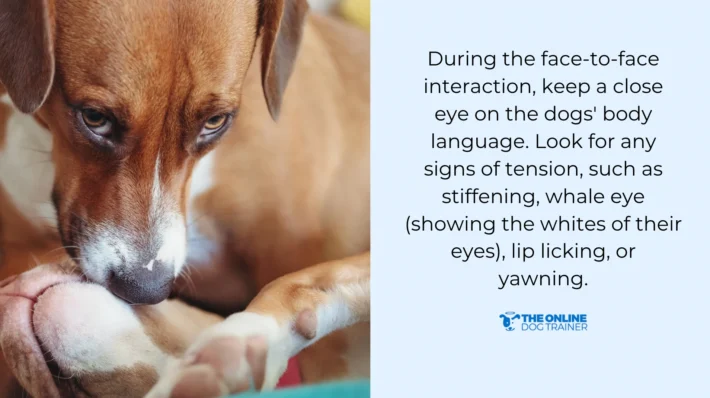
During the face-to-face interaction, keep a close eye on the dogs' body language. Look for any signs of tension, such as stiffening, whale eye (showing the whites of their eyes), lip licking, or yawning.
Recognizing canine body language before tension or escalation, allows you to calmly intervene. Create distance or using a distraction. The key is to remain calm and assertive, reassuring your dog that you are in control.
Even if there's a minor scuffle, don't overreact. Most scuffles are just noise and posturing. End the session positively, and try again another day. With patience and consistency, the dogs will likely learn to interact peacefully.
Post-Introduction Tips
After a successful introduction, here are some tips to ensure continued harmony between the dogs:
- Establish Routines: Creating consistent routines for feeding, playing, and resting can help the dogs coexist peacefully. A calm dog loves predictability, which can reduce anxiety and tension.
- Monitor and Manage: Continue to monitor their interactions, even after the initial introduction. If one dog becomes overly excited, noisy, or starts to dominate the other, calmly intervene. You can use a slip leash to gently redirect the overly enthusiastic dog, giving the other dog some space.
- Equal Playtime: Ensure both dogs have equal opportunities to play and interact. If one dog is more energetic, allow them to burn off some energy before interacting with the other dog. This can help prevent overexcitement and potential conflict.
- Respect Individual Needs: Be mindful of each dog's individual preferences and needs. If one dog seems less interested in playing at a particular moment, respect their boundaries and give them space. Recognizing canine body language can help stop any untoward incidents during the introduction.
Common Challenges on Reactive Dog Training and How to Overcome Them
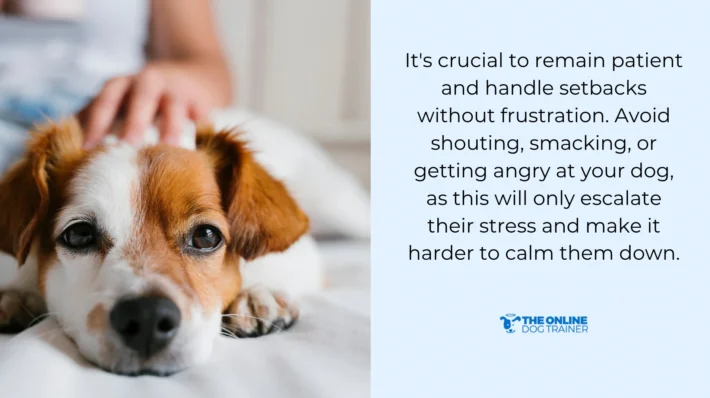
Introducing reactive dogs can come with its fair share of challenges. Here's how to navigate some common hurdles:
- Barking and Lunging: If your dog barks or lunges during the introduction process, don't see it as a complete failure. It's simply a hurdle to overcome, a part of the journey.
- Staying Calm: It's crucial to remain patient and handle setbacks without frustration. Avoid shouting, smacking, or getting angry at your dog, as this will only escalate their stress and make it harder to calm them down. Remember, your dog mirrors your emotions, so staying calm is key.
- Environmental Factors: Be mindful of your surroundings. If you're feeling stressed due to the environment (e.g., too hot, too cold, noisy), your dog will sense it. Sometimes, a simple change in the environment can make a big difference.
- When to Seek Professional Help: If you're truly struggling with true aggression, consider seeking professional help from a certified dog trainer or behaviorist. However, before you do, make sure you've established a clear leadership role with your dog. Many training programs focus on treating the symptoms of reactivity, but addressing the root cause, which is often a lack of clear leadership, is essential for long-term success.
Conclusion From The Dog Trainer: Be Consistent, Patient, and Use The Dog Calming Code
To conclude, the most important thing is to remain patient and consistent. Implementing the Dog Calming Code before you even leave the house can make a significant difference. By shifting your dog's mindset— helping them understand their role, that they are not in charge of decision-making, and that they don't have to assess danger —you change everything.
It's also crucial to celebrate all the small successes you achieve with your dog. Remember, overcoming aggressive behavior takes time; it's rarely an overnight transformation. With the Dog Calming Code, you can expect to see positive changes within one to two weeks.
If you've been working on dog training for a while and haven't seen the desired results, it might be because the Dog Calming Code hasn't been implemented, and your dog still believes they are in charge. To foster a harmonious relationship between your dog and other dogs, consider addressing this root cause. You can learn more about the Dog Calming Code and how it can help you by clicking on the link below. I'm here to guide you through the process and support you on your journey to a calmer, happier dog.

~Doggy Dan 🙂

